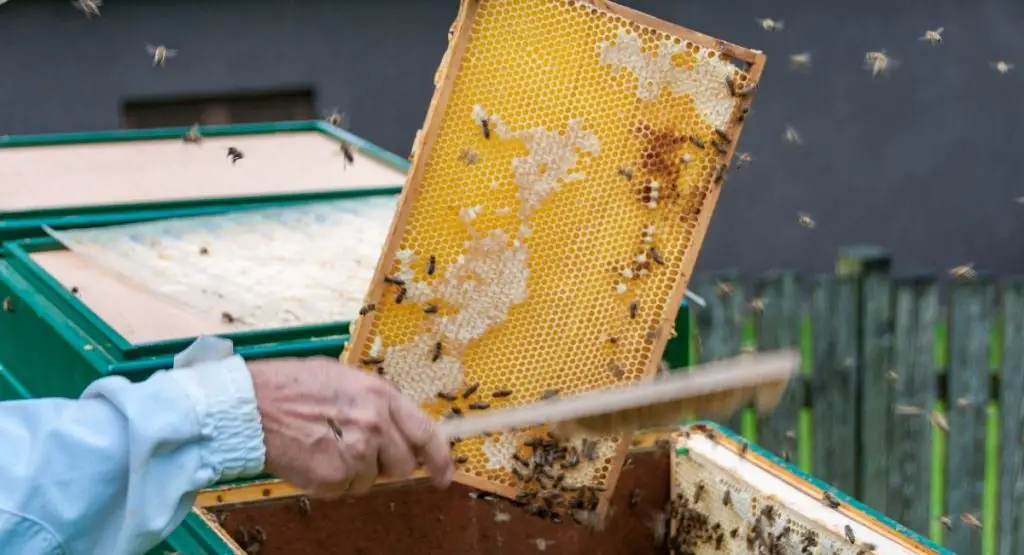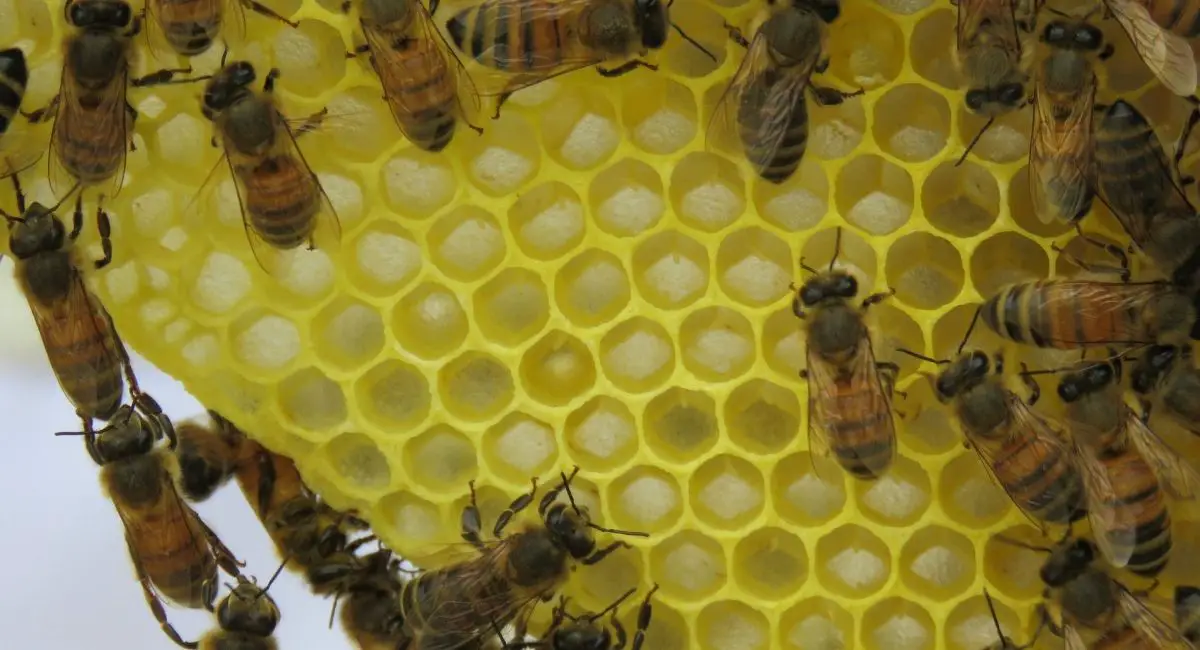If you’re fresh from taking beekeeping courses or even have a good beekeeping instructor, the question uppermost in your mind might be: how long does it take for bees to make honey?
Whether you took a beekeeping class to learn more about these unique creatures or you’re after the delicious health-enhancing raw honey they produce, knowing how these processes work are essential for you as a beginner beekeeper.
Of course, it also helps that harvesting honey can be a very lucrative enterprise for backyard beekeepers. To that end, you need to understand the variables that affect when and how you get pounds of honey from your frame hive.
This means knowing the variables that affect the life cycle of your honey bees. Without further ado, here’s what you need to know about what goes into the honey harvesting process.
Table of Contents

Everything to Know About Honey Flow and Honey Harvest
Honey bees typically collect nectar from flowers from spring to early summer. The process of nectar collection from the anthers of flowers is integral because it directly influences what you record in the production season.
As long as the worker honey bees can find 50-100 flowers or more from which to collect nectar, they will continue to manufacture delicious health-enhancing raw honey.
In addition to getting enough nectar from flowers, strong bee colonies also need enough space in their frame hive to store the honey. Experienced keepers ensure that the frame hive they house bee colonies contains enough room for the storage and ripening of the substance.
While it might not be immediately obvious, the amount of honey flow depends on your frame hive management and the season and climate in your region.
A strong colony produces about 55 pounds of raw honey annually. Each of the worker honey bees contributes 1/12 of a teaspoon of honey to this throughout their lifetime. Worker honey bees only live for a couple of weeks.
At the height of a good honey flow, the average honey bee colony can produce and store as much as 10 pounds of honey each day.
Major Factors That Influence Your Bee Colony Honey Flow
1. The health status of your beehive.
2. Availability of anthers of flowers with adequate nectar.
3. Amount of space available in the hive.
So, how long does it take for bees to make honey? Moving further, we’ll be looking at just how these parameters help us answer that question.
The Health Status of Your Bee Hive
It’s a given that, on your beekeeping journey, ensuring the health of your honey bees is a top priority. A healthy hive is very important for several reasons.
Your colony health has a direct bearing on how your worker honey bees perform during the production season. More precisely, when a healthy and strong colony has a strong queen bee, the population is more inclined to thrive more and work harder. When all your honey-making bees are in good health and the atmospheric conditions are acceptable, a large supply of honey is ensured.
That being said, if you spot additional swarms or a clustered swarm as your bee hive population grows, this might signal a problem. When hives form a clustered swarm in the course of a honey flow, there will be a considerable drop in that production season. This is because bee swarms split the colony and significantly reduce their activities.
Another thing you need to be on the lookout for is disease in your bee colony. This is extremely important as a colony of bees in poor health can’t produce sufficient delicious health-enhancing raw honey.
Lastly, if you’re dealing with present pest problems or you want to forestall future best infestations, ensure that you don’t expose your bees to any pesticides. Failure to do so might negatively affect the purity levels of your honey and lower the integrity of the honey-making bees.
The Availability of Daily Food from Flowers
Worker honey bees have a limited foraging range. These honey bees typically don’t go further than a one to two-mile radius from the frame hive. So, to make the most of the production season, experienced beekeepers choose the location they establish a colony of bees in very carefully.
However, in cases when you have limited control over where you establish your European honey bees, there are a few things you can do. In addition to providing supplements like dextrose sugars with sugar water, you can also grow plant life rich in the type of nectar bees favor.
Honey bees are naturally drawn to plants with a high content of nectar because it requires less energy to process. Because it doesn’t take them much effort to reduce the moisture content in this nectar, they can gather faster and improve the rate of production of good-quality raw honey.
When looking for these types of flowers to plant, consider:
- The quantity of nectar the plant typically secretes.
- The number of flowers that you should plant within the foraging range to help the honey flow.
Once you have this information, you can plant 50-100 flowers that meet these requirements and improve what your colony of bees could manufacture during the production season.
Amount of Space Available in the Hive
For bee hives that have already been producing honey, drawn combs in flow frames would have been created to facilitate efficient honey flow.
But, if you’re a beginner beekeeper, you’ll need to get the essential beehive hardware to create drawn combs for your flow frames. Failing to do this will result in a strong honey flow as the worker honey bee colony will draw out the frames, since bees only produce beeswax in readiness for a given purpose.
One such purpose is the honey flow, and their glands are stimulated to produce the bit of beeswax necessary for the task at hand. That means they use the larger portion of their energy and nectar reserve to draw beeswax combs rather than produce delicious honey. Consequently, you’ll notice a significant drop during the production season.
How Long Does it Take for Bees to Make Honey?
Knowing all of the above, it takes about 3-4 weeks for your hive to start producing honey under average conditions.
Still, you might have to be a little patient if you want to see continuous results. Due to several reasons, beekeepers typically collect the honey from new hives at different times.
Why You Should Be Patient with a New Hive
To get surplus honey, you have to take extreme care with your worker bees. The reason a lot of beekeepers tend to exercise patience with their honey bee hives is to ensure they become strong enough to manufacture honey for many more years.
When you don’t deprive your bees of the first batch of honey they produce, you help them maintain and gradually build energy levels.
In addition to this, the speed with which your beehives build beeswax comb depends on various factors. like weather and geographic location. This also has a bearing on how soon you can harvest excess honey.
If you live in Southern California for example, you should be able to harvest honey faster without putting your colony of bees at risk. However, if you do skip the first year, you help your colony get even stronger and become more established, thanks to the relatively constant temperature.
Beehive Robbing – What It Is and How to Prevent It
Beehive robbing is a situation that compels bees in one colony to seize the resources of another colony. The bees in the first colony enter the brood box or brood combs of another colony and steal their stored resources, like nectar.
Proper brood rearing with the right beehive tools alone is not enough to prevent such a grand theft from occurring in many cases.
Why Does Beehive Robbing Occur?
Several colonies of bees can leave together without any incident of the honey yield of one colony getting robbed by the other. When there is an ample supply of resources, and the bees don’t have to go far to get whatever they need, this phenomenon isn’t likely to occur.
However, if one colony loses its queen and begins to struggle or is attacked by pests, it might resort to beehive robbing to survive.
Ways to Prevent Hive Robbing
- · Ensure you build a strong colony of common honey bees.
- · Reduce the access that one colony has to another.
- · Feed intelligently with resources like sugar syrup or Dextrose sugars.
Final Word
Now that you know how long does it take for bees to make honey, and other useful info about the honey lifecycle, you’re better equipped to take care of your hive, even if you’re a beginner beekeeper. What’s more, you can easily decide what you want to do when your first honey flow arrives! To add more to your repertoire of skills, check this out!


